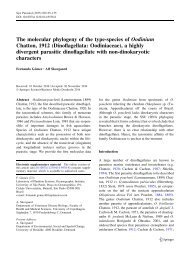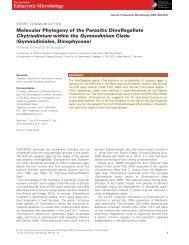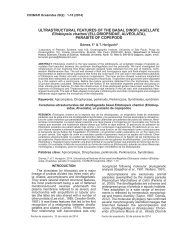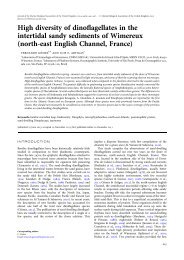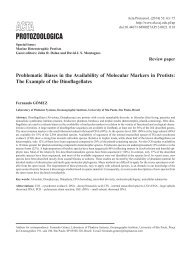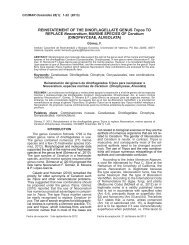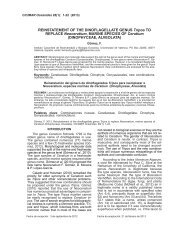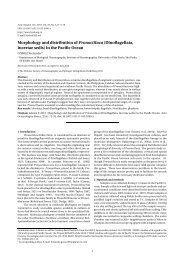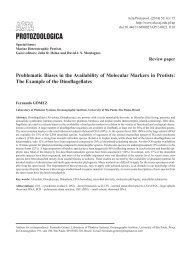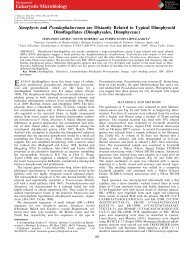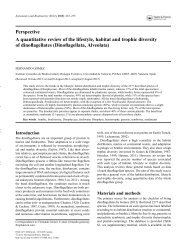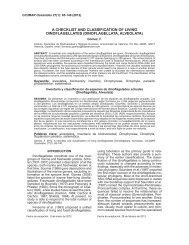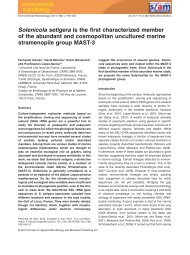The formation of the twin resting cysts in the dinoflagellate Dissodinium pseudolunula, a parasite of copepod eggs
The dinoflagellate Dissodinium pseudolunula is the most common and widespread ectoparasite of copepod eggs in neritic waters. When the host is absent, the species survives with a distinctive pair of twin resting cysts described as Pyrocystis margalefii. Based on live samples, the formation of the twin resting cysts is illustrated here for the first time. The gymnodinioid infective cells did not form overwintering cysts under unfavourable conditions. These are formed inside the secondary lunate sporangium
The dinoflagellate Dissodinium pseudolunula is the most common and widespread ectoparasite
of copepod eggs in neritic waters. When the host is absent, the species survives
with a distinctive pair of twin resting cysts described as Pyrocystis margalefii. Based
on live samples, the formation of the twin resting cysts is illustrated here for the first
time. The gymnodinioid infective cells did not form overwintering cysts under
unfavourable conditions. These are formed inside the secondary lunate sporangium
Create successful ePaper yourself
Turn your PDF publications into a flip-book with our unique Google optimized e-Paper software.
JOURNAL OF PLANKTON RESEARCH j VOLUME 35 j NUMBER 5 j PAGES 1167–1171 j 2013<br />
d<strong>in</strong>ospores <strong>in</strong>fest planktonic crustacean <strong>eggs</strong>, absorb <strong>the</strong><br />
host contents and form two successive sporangia (a globular<br />
primary sporangium followed by eight crescent lunate<br />
secondary sporangia which develop from <strong>the</strong> former) that<br />
produce new <strong>in</strong>fective gymnod<strong>in</strong>ioid d<strong>in</strong>ospores (Drebes,<br />
1978). <strong>The</strong> species survives <strong>the</strong> host-free season as <strong>rest<strong>in</strong>g</strong><br />
<strong>cysts</strong>. Drebes (Drebes, 1981) was able to germ<strong>in</strong>ate a d<strong>in</strong><strong>of</strong>lagellate<br />
<strong>rest<strong>in</strong>g</strong> cyst, known as Pyrocystis margalefii, <strong>in</strong><br />
culture and he observed that <strong>the</strong> gymnod<strong>in</strong>ioid d<strong>in</strong>ospores<br />
were identical to those <strong>of</strong> Dissod<strong>in</strong>ium <strong>pseudolunula</strong>. However,<br />
he was unable to verify whe<strong>the</strong>r <strong>the</strong> d<strong>in</strong>ospores were able<br />
to <strong>in</strong>fect <strong>copepod</strong> <strong>eggs</strong>. <strong>The</strong>se dist<strong>in</strong>ctive pairs <strong>of</strong> <strong>tw<strong>in</strong></strong><br />
<strong>rest<strong>in</strong>g</strong> <strong>cysts</strong> are widely distributed <strong>in</strong> <strong>the</strong> plankton <strong>of</strong><br />
<strong>the</strong> eastern North Atlantic and North Sea with a peak<br />
<strong>in</strong> numbers <strong>in</strong> August and September (John and Reid,<br />
1983). Molecular phylogeny has revealed that Dissod<strong>in</strong>ium<br />
and Chytriod<strong>in</strong>ium, both ecto<strong>parasite</strong>s <strong>of</strong> crustacean <strong>eggs</strong>,<br />
are close relatives with<strong>in</strong> <strong>the</strong> group <strong>of</strong> Gymnod<strong>in</strong>ium sensu<br />
stricto (Gómez et al., 2009).<br />
Drebes (Drebes, 1981) demonstrated that <strong>the</strong> <strong>in</strong>fective<br />
d<strong>in</strong>ospores that emerged from <strong>the</strong> <strong>tw<strong>in</strong></strong> <strong>rest<strong>in</strong>g</strong> cyst resemble<br />
those <strong>of</strong> Dissod<strong>in</strong>ium <strong>pseudolunula</strong>. However, <strong>the</strong> stage <strong>of</strong><br />
Fig. 1. Light micrographs <strong>of</strong> life stages <strong>of</strong> live specimens <strong>of</strong> Dissod<strong>in</strong>ium <strong>pseudolunula</strong> collected <strong>in</strong> <strong>the</strong> coastal NE English Channel <strong>in</strong> 2010 and 2011.<br />
(A–E) Infected <strong>copepod</strong> <strong>eggs</strong>. (F–Q) Developmental stages <strong>of</strong> <strong>the</strong> globular primary sporangia. (R–AE) Developmental stages <strong>of</strong> <strong>the</strong> lunate<br />
secondary sporangia. (AE–AH) Infective d<strong>in</strong>ospore enclosed <strong>in</strong> an outer hyal<strong>in</strong>e membrane. fl, flagellum. Scale bar: 10 mm. See onl<strong>in</strong>e<br />
supplementary data for a colour version <strong>of</strong> this figure.<br />
1168



